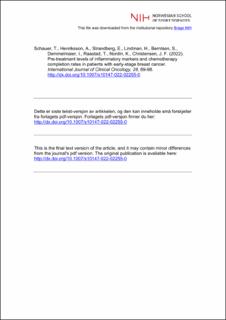| dc.contributor.author | Schauer, Tim | |
| dc.contributor.author | Henriksson, Anna | |
| dc.contributor.author | Strandberg, Emelie | |
| dc.contributor.author | Lindman, Henrik | |
| dc.contributor.author | Berntsen, Sveinung | |
| dc.contributor.author | Demmelmaier, Ingrid | |
| dc.contributor.author | Raastad, Truls | |
| dc.contributor.author | Nordin, Karin | |
| dc.contributor.author | Christensen, Jesper F. | |
| dc.date.accessioned | 2023-10-25T07:13:56Z | |
| dc.date.available | 2023-10-25T07:13:56Z | |
| dc.date.created | 2022-11-23T14:03:31Z | |
| dc.date.issued | 2022 | |
| dc.identifier.citation | International Journal of Clinical Oncology. 2022, 28, 89–98. | en_US |
| dc.identifier.issn | 1341-9625 | |
| dc.identifier.uri | https://hdl.handle.net/11250/3098564 | |
| dc.description | I Brage finner du siste tekst-versjon av artikkelen, og den kan inneholde ubetydelige forskjeller fra forlagets pdf-versjon. Forlagets pdf-versjon finner du på link.springer.com / In Brage you'll find the final text version of the article, and it may contain insignificant differences from the journal's pdf version. The definitive version is available at link.springer.com | en_US |
| dc.description.abstract | Background Chemotherapy efcacy is largely dependent on treatment adherence, defned by the relative dose intensity (RDI). Identifcation of new modifable risk factors associated with low RDI might improve chemotherapy delivery. Here, we evaluated the association between low RDI and pre-chemotherapy factors, including patient- and treatment-related characteristics and markers of infammation. Methods This exploratory analysis assessed data from 267 patients with early-stage breast cancer scheduled to undergo (neo-)adjuvant chemotherapy included in the Physical training and Cancer (Phys-Can) trial. The association between low RDI, defned as<85%, patient-related (age, body mass index, co-morbid condition, body surface area) and treatment-related factors (cancer stage, receptor status, chemotherapy duration, chemotherapy dose, granulocyte colony-stimulating factor) was investigated. Analyses further included the association between RDI and pre-chemotherapy levels of interleukin (IL)-6, IL-8, IL-10, C-reactive protein (CRP) and Tumor Necrosis Factor-alpha (TNF-α) in 172 patients with available blood samples. Results An RDI of<85% occurred in 31 patients (12%). Univariable analysis revealed a signifcant association with a chemotherapy duration above 20 weeks (p<0.001), chemotherapy dose (p=0.006), pre-chemotherapy IL-8 (OR 1.61; 95% CI (1.01; 2.58); p=0.040) and TNF-α (OR 2.2 (1.17; 4.53); p=0.019). In multivariable analyses, infammatory cytokines were signifcant association with low RDI for IL-8 (OR: 1.65 [0.99; 2.69]; p=0.044) and TNF-α (OR 2.95 [1.41; 7.19]; p=0.007). Conclusions This exploratory analysis highlights the association of pre-chemotherapy IL-8 and TNF-α with low RDI of chemotherapy for breast cancer. IL-8 and TNF-α may therefore potentially help to identify patients at risk for experiencing dose reductions. | en_US |
| dc.language.iso | eng | en_US |
| dc.subject | chemotherapy | en_US |
| dc.subject | relative dose intensity | en_US |
| dc.subject | breast cancer | en_US |
| dc.subject | tumor necrosis factor-alpha | en_US |
| dc.subject | interleukin-8 | en_US |
| dc.title | Pre-treatment levels of inflammatory markers and chemotherapy completion rates in patients with early-stage breast cancer | en_US |
| dc.title.alternative | Pre-treatment levels of inflammatory markers and chemotherapy completion rates in patients with early-stage breast cancer | en_US |
| dc.type | Peer reviewed | en_US |
| dc.type | Journal article | en_US |
| dc.description.version | acceptedVersion | en_US |
| dc.source.pagenumber | 10 | en_US |
| dc.source.journal | International Journal of Clinical Oncology | en_US |
| dc.identifier.doi | 10.1007/s10147-022-02255-0 | |
| dc.identifier.cristin | 2079324 | |
| dc.description.localcode | Institutt for fysisk prestasjonsevne / Department of Physical Performance | en_US |
| cristin.ispublished | true | |
| cristin.fulltext | postprint | |
| cristin.qualitycode | 1 | |
